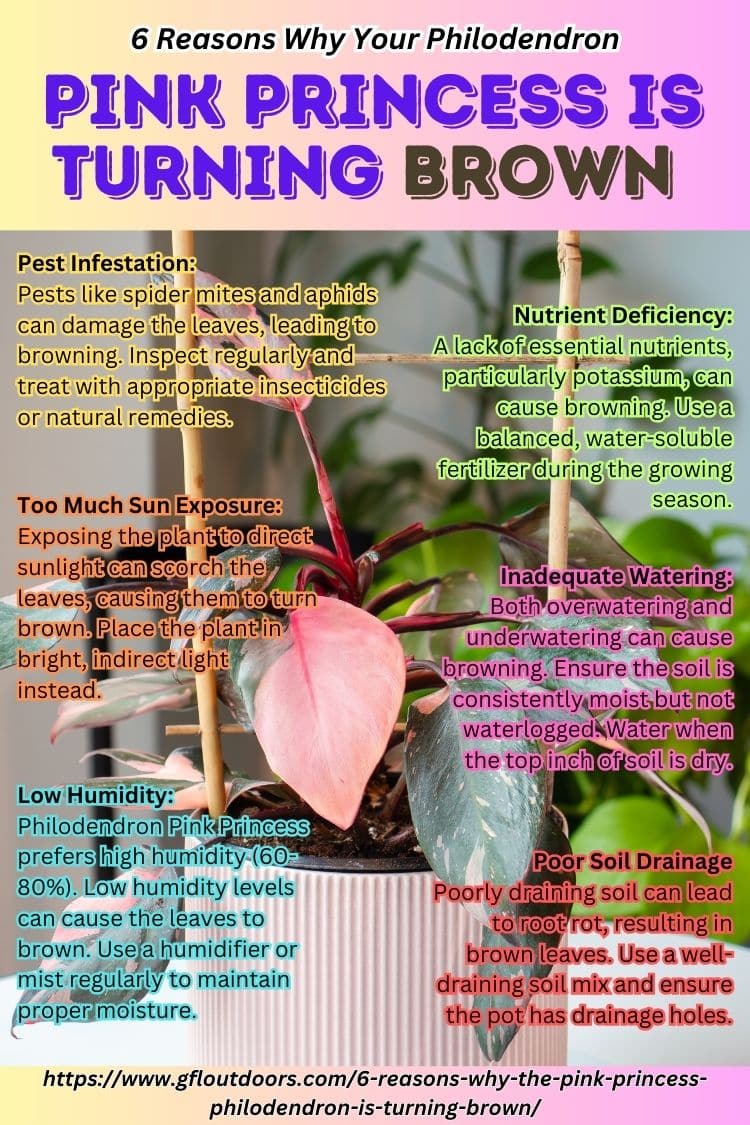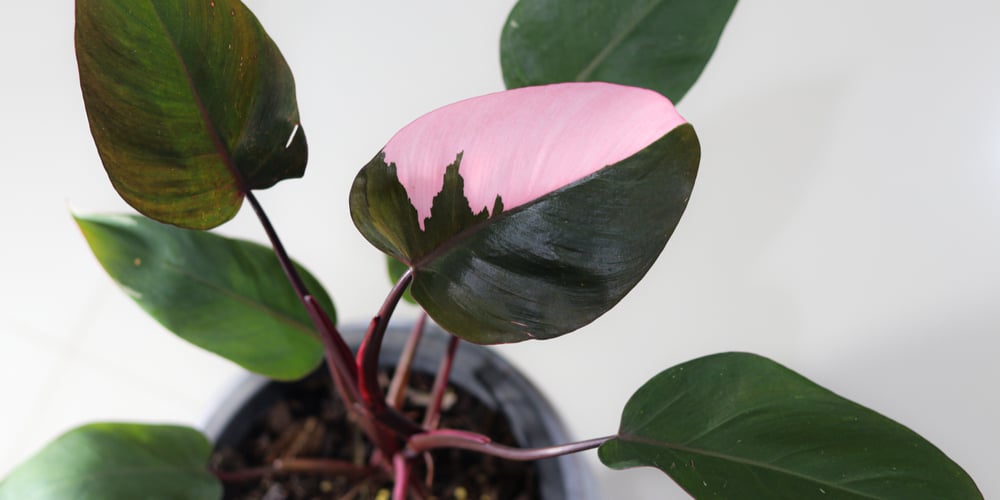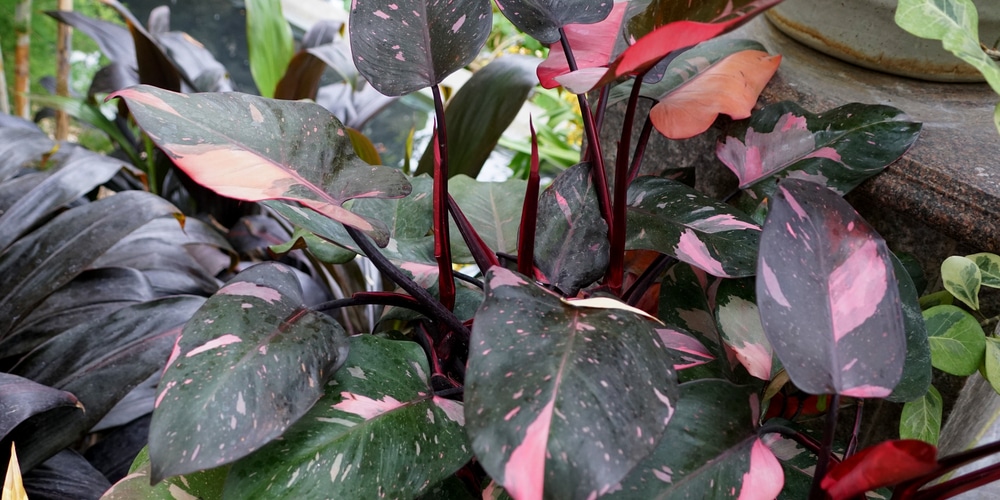Dive Into the Pink Princess Philodendron
Mastering the essentials of watering and lighting is your royal decree to save the browning Pink Princess Philodendron. Your glorious green-thumb quest awaits, so let’s suit up and tend to these regal needs!
The Royal Roots: Watering Woes
- Check the Moisture: Your Pink Princess craves just the right sip of water. Use your fingertip or a moisture meter to check. The top inch of soil should be dry before you water again.
- Drainage is Key: Ensure your pot has drainage holes to prevent water from pooling at the bottom, which can lead to root rot.Watering tips:
- Morning watering is ideal.
- Room temperature water works best.
For more insight on watering woes, visit this guide on Philodendron Pink Princess care.
Sunlight Soiree: Light Requirements
- Bright, Indirect Light: This is the sunlight sweet spot. Your Pink Princess will show signs of distress if left in the dark or directly under the scorching sun.Light level tips:
- Avoid direct midday sun, which can scorch leaves.
- If lower leaves are shedding, it might be a sign of too little light.
Check out thoughts on lighting and Philodendron care for further details.
Browning Begone: Troubleshooting Tips
When your Pink Princess Philodendron starts turning an unsightly brown, it’s a clear signal that your royal plant is in distress. Let’s shed some light and zero in on a couple of troublemakers: tiny critters and sneaky fungi.
Pest Patrol: Uninvited Guests
Your Pink Princess might be hosting a party for pests without your invitation. Here’s what you need to check:
- Lookout for Looters: Inspect your plant for common culprits like spider mites, mealybugs, and aphids. They’re tiny but they’ll leave clear signs like webbing, a cottony substance, or sticky residue.
- Eviction Notice: Once you’ve identified the pests, it’s time to take action.
- Gently wipe down the leaves with a soft cloth dipped in soapy water.
- For tougher cases, organic neem oil can be a safe and effective pest control.
- Keep a consistent watch—these unwanted guests can be persistent.
Remember, routine inspections will keep pest parties to a minimum and your Pink Princess flourishing.
Fungal Fiascos: Identifying Infections
Fungi can be fiendish foes for your foliage. Brown spots might mean your plant is under fungal attack.
- Spot the Spots: Fungal infections often manifest as dark, concentric circles or irregular patches on the leaves.
- Cut it Out: Here’s the plan of attack:
- Prune affected leaves with sterilized scissors to prevent the spread.
- Avoid overhead watering which can create a wet haven for fungi to thrive.
Keep plant leaves dry and ensure good air circulation; your Pink Princess will thank you by sporting healthy, vibrant leaves.
Nutrients and Nourishment Needs
Just like your favorite outdoor adventure requires the right fuel, so does your Pink Princess Philodendron to avoid that dreaded browning. Let’s gear up with the right nutritional know-how.
Feeding Your Philodendron: Fertilizer Facts
- What to Feed: Philodendrons are not picky eaters, but they do have a palate for balanced, nutrient-rich fare. A fertilizer with a good N-P-K ratio, such as 20-20-20, will satisfy their hunger and support lush, vibrant growth.
- Nitrogen (N): Promotes healthy, green leaf development.
- Phosphorus (P): Supports root growth and blooming, if your Philodendron ever decides to flower.
- Potassium (K): Helps with overall plant vigor and disease resistance.
- When to Feed: Serve up this botanical feast during the growing season, from spring through summer. Think of it as a seasonal buffet, offering meals every 4-6 weeks. Come fall and winter, your plant goes into hibernation mode, so no need to feed.
- Overfeeding Symptoms: On the lookout for a classic case of too much of a good thing? Overfeeding can lead to salt build-up, causing those brown, crispy leaf tips. Think of it as a nutrient overdose.
- Underfeeding Symptoms: If your Philodendron is looking a bit pale and lackluster, it might be asking for a little more on its plate. Yellowing leaves can be a cry for more nitrogen.
Remember, the Pink Princess Philodendron doesn’t just want to survive; with the right nutrients, it’ll thrive—just like you conquering that mountain trail with a backpack full of snacks. Keep it well-fed, and you’ll keep those leaves royally radiant!
Creating the Perfect Environment
Giving your Pink Princess Philodendron the royal treatment it deserves hinges on nailing the right humidity and pruning practices. Let’s ensure your leafy friend is living in luxury!
Humidity Haven: Crafting Comfort
Your Pink Princess Philodendron is a bit like you on a tropical vacation—it thrives when the moisture in the air is just right! Here’s how you can dial up the humidity to suit your plant’s preferences:
- Aim for around 50% humidity, akin to the plant’s native jungle conditions.
- Place your plant on a pebble tray filled with water to create a small, humid microclimate.
- Consider using a humidifier; these devices can be a game-changer, especially during drier months.
- As a fun DIY method, mist your Philodendron’s leaves a few times a week — think of it as giving your plant a mini tropical rainstorm!
Philodendron Pink Princess will grow best in an environment with the right humidity.
Pruning Proficiency: Growth and Grooming
Pruning isn’t just tidying up; it’s essential for keeping your Pink Princess in its prime! Here’s a quick pruning guide:
- Disinfect your shears before you start — cleanliness is next to plant-godliness!
- Snip away any brown or dead leaves at the stem to redirect energy to healthier growth.
- Don’t shy away from trimming leggy vines; it encourages a bushier and more splendid plant.
- Remember that pruning is also a way to propagate — those cuttings can give you more royal beauties to cherish!
By following these humidity and pruning tips, you’ll create a regal realm that encourages your Pink Princess to flourish with vibrant, healthy foliage. Happy gardening, your majesty!
Frequently Asked Questions
Tackling browning in your Pink Princess Philodendron can be like solving a botanical puzzle. Each symptom acts as a clue leading to a thriving plant paradise.
Why are the leaves on my Pink Princess Philodendron developing brown spots?
Your tropical darling hates being thirsty—underwatering causes brown spots. It craves consistent moisture, yet despises soggy feet. Strike that perfect watering balance to keep those leaves spot-free.
What causes a Pink Princess Philodendron’s new leaves to turn brown?
New leaves turning brown is like a cry for attention. Often, it’s a stress signal—perhaps a drafty window or a heat vent nearby. Your plant’s telling you to find it a more suitable throne.
How can overwatering affect my Pink Princess Philodendron, and could it lead to browning?
Pouring too much love—aka water—can drown its royal roots, causing browning leaves as a sign of distress. Your Philodendron prefers the ‘just enough’ approach to water.
Is there a connection between drooping Pink Princess Philodendron leaves and them turning brown?
Indeed, drooping leaves can be a prelude to browning. It’s the plant’s slump of unhappiness, often due to moisture mishaps. Regular checks can prevent the droop from turning into a browning saga.
Can yellowing leaves on my Pink Princess Philodendron indicate a problem that may also cause browning?
Yellow leaves might herald the browning blues. Nutrient imbalance or pests could be the culprits. Keep an eye on leaf color changes to nip issues in the bud before brown takes over.
What are the signs of root rot in a Pink Princess Philodendron, and can it cause the plant to turn brown?
Root rot in Philodendrons is like the hidden menace beneath the soil. When roots get soggy and start to decay, it’s only a matter of time before the browning follows.iazza
Last update on 2025-03-31 / Affiliate links / Images from Amazon Product Advertising API








